Charles E W Bean, Diaries, AWM38 3DRL 606/260/1 - 1916 - 1930 - Part 13
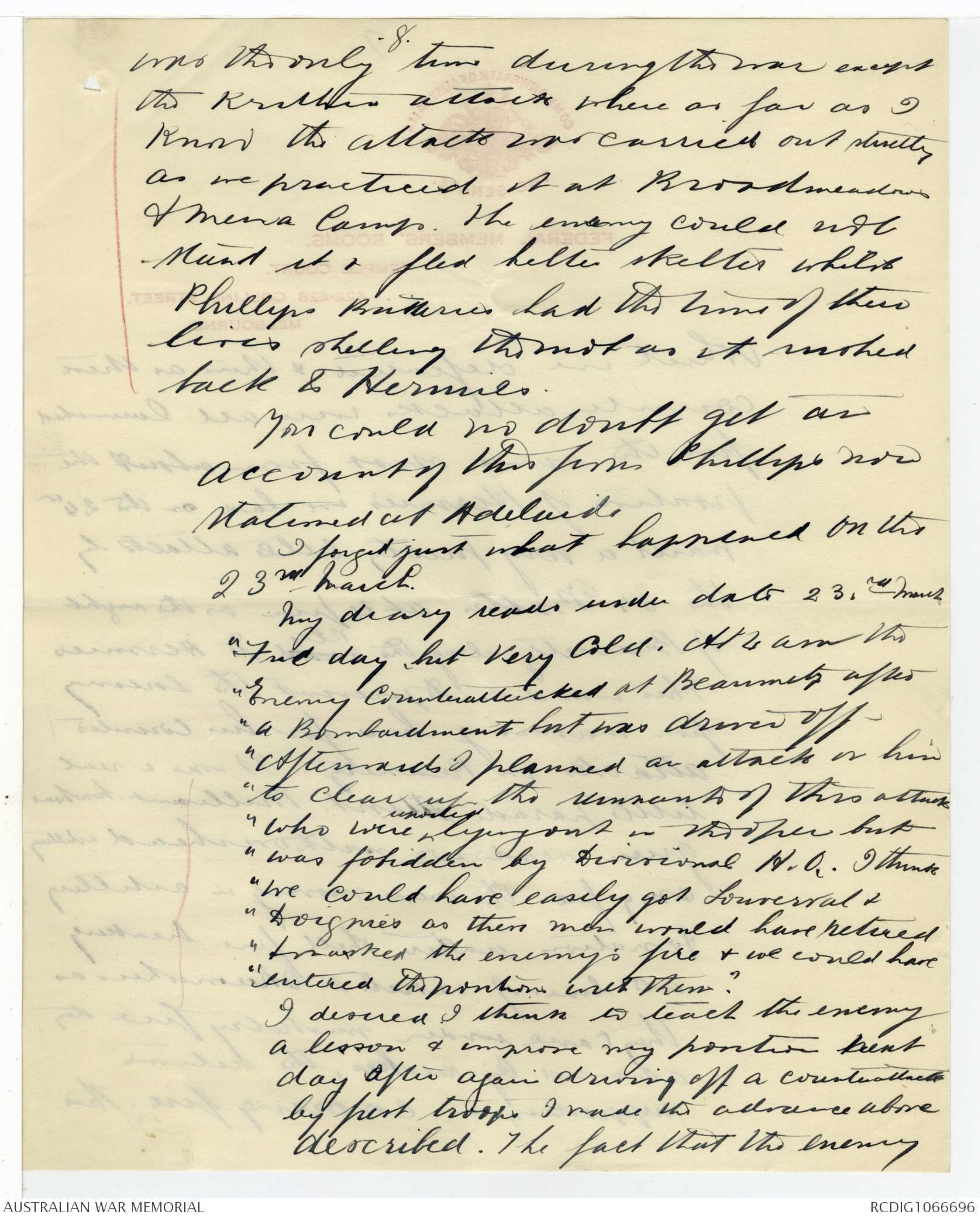
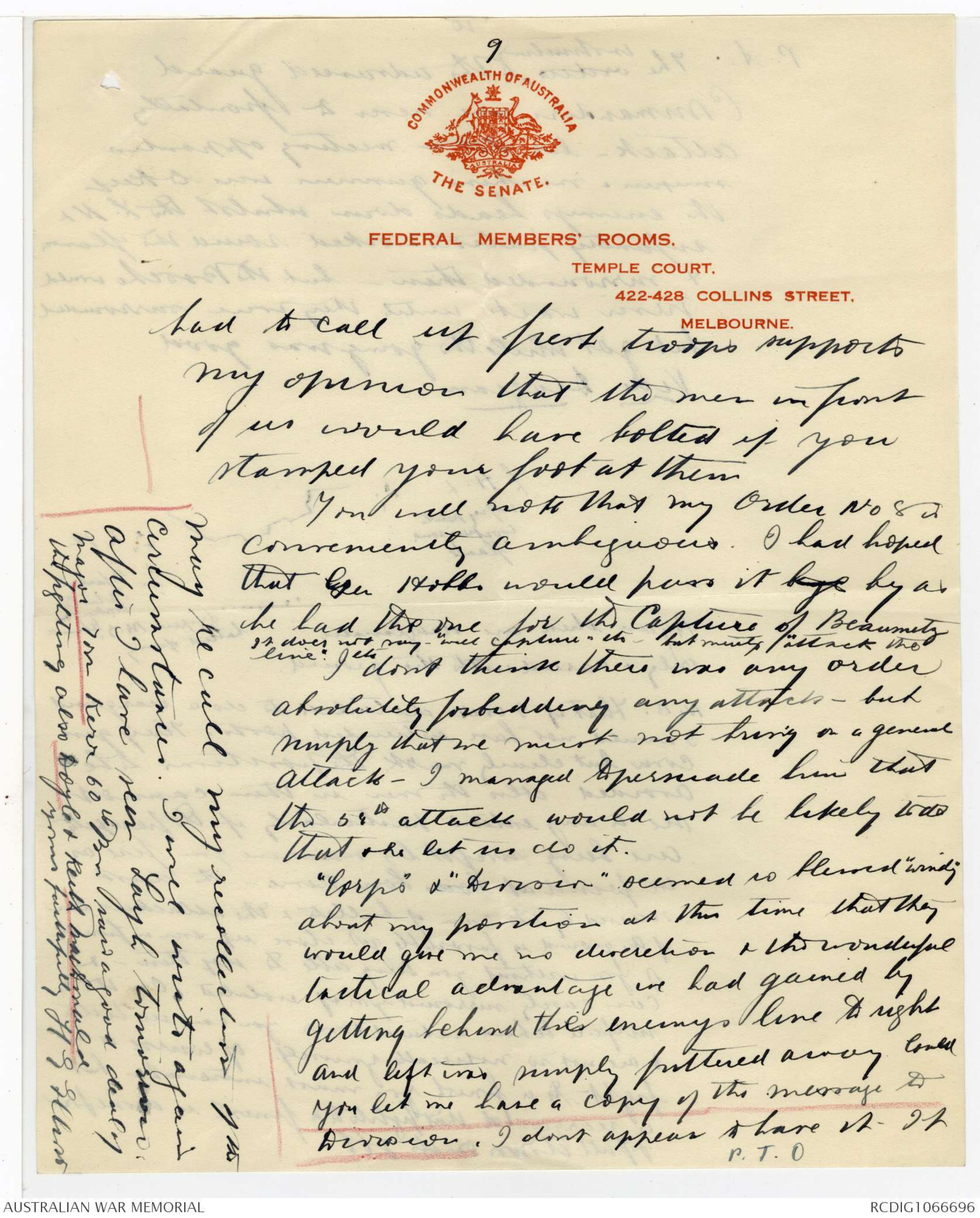
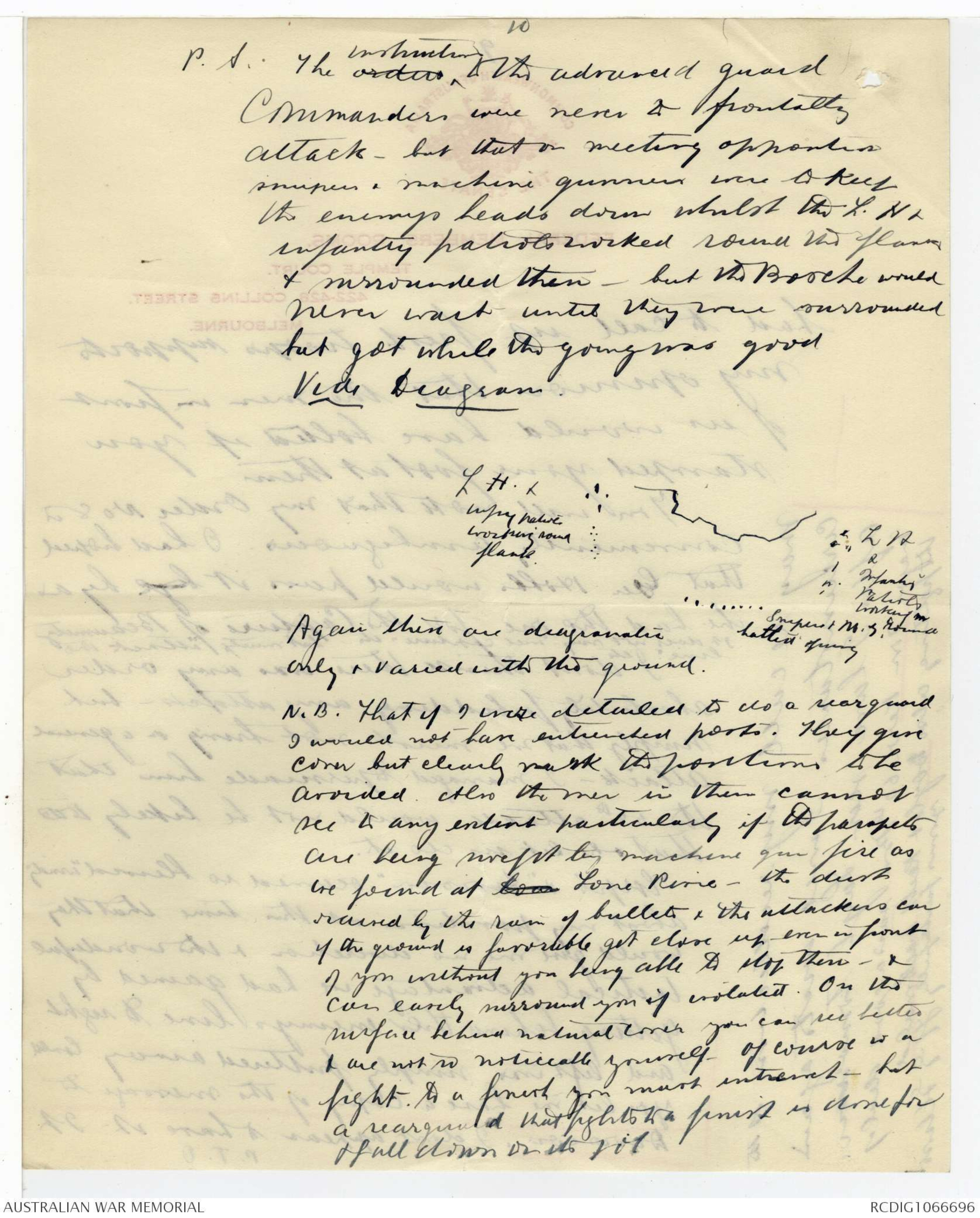
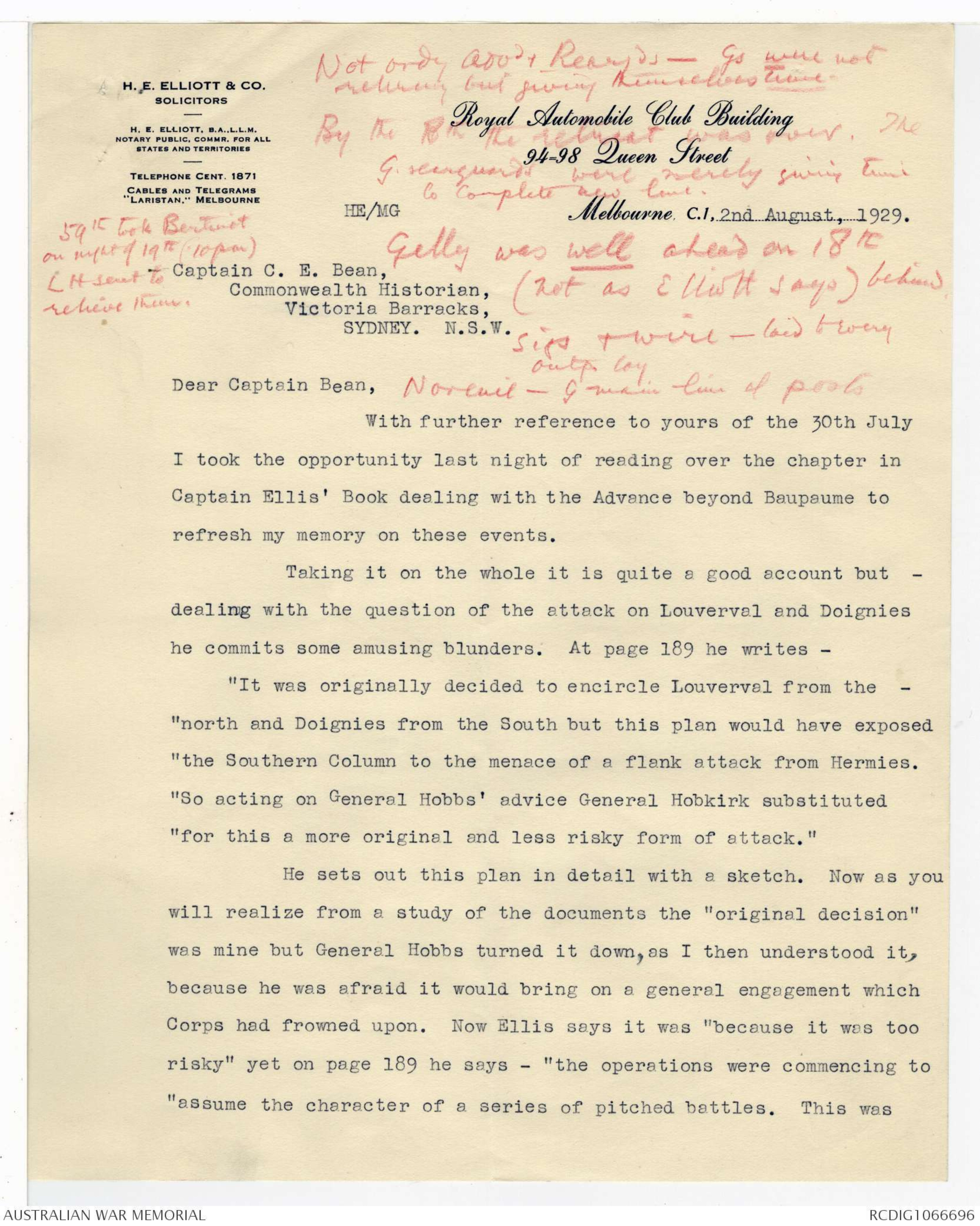
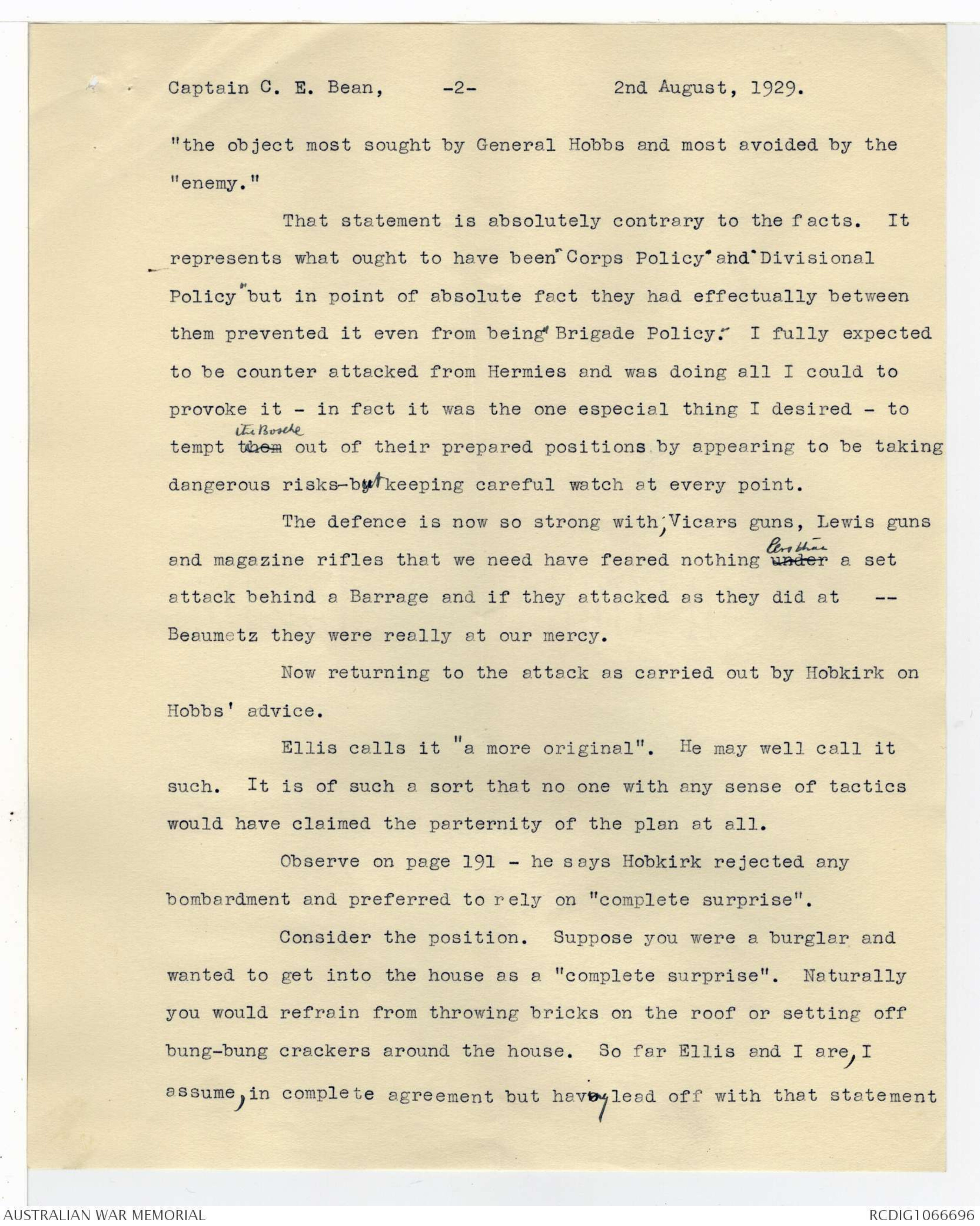
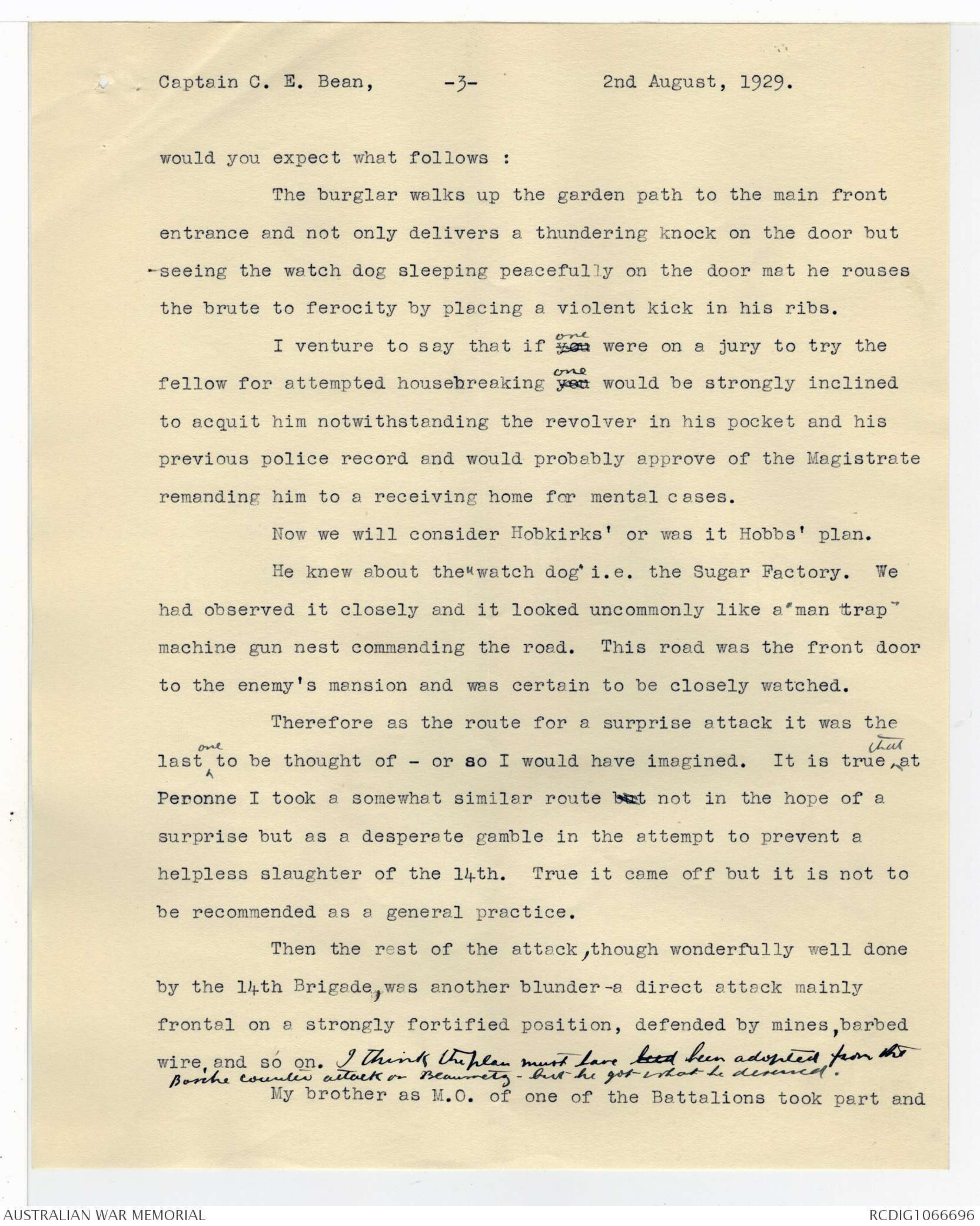
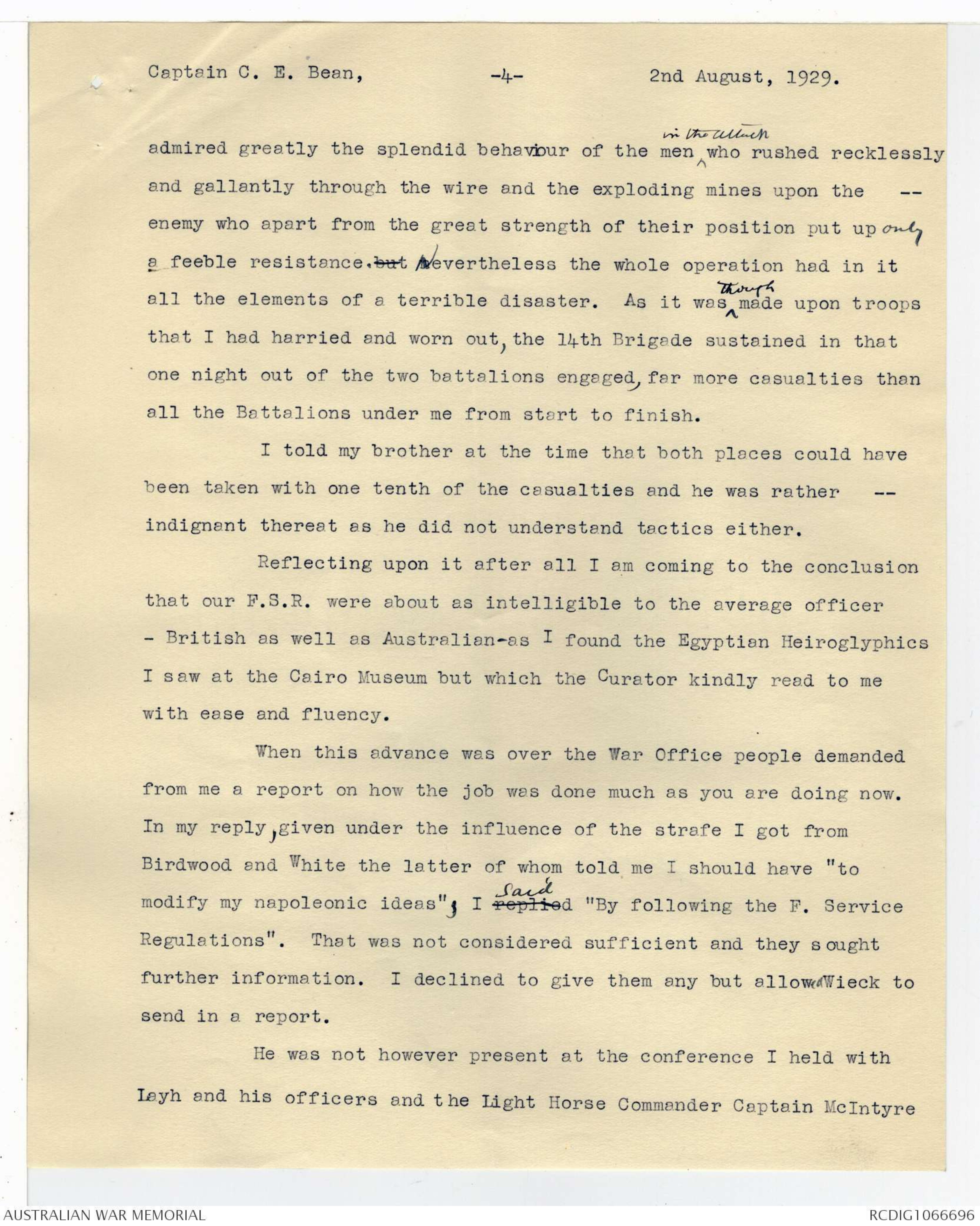
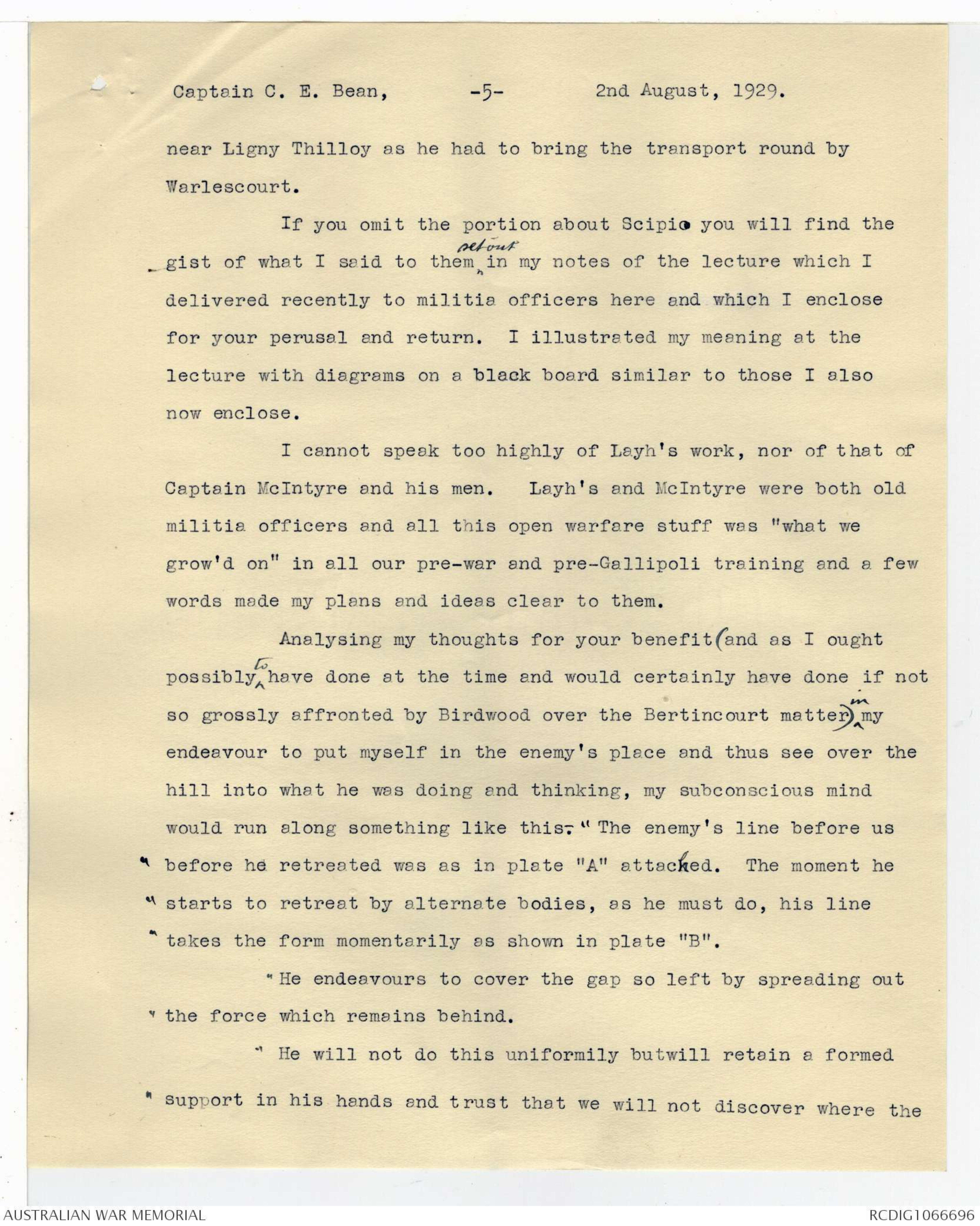
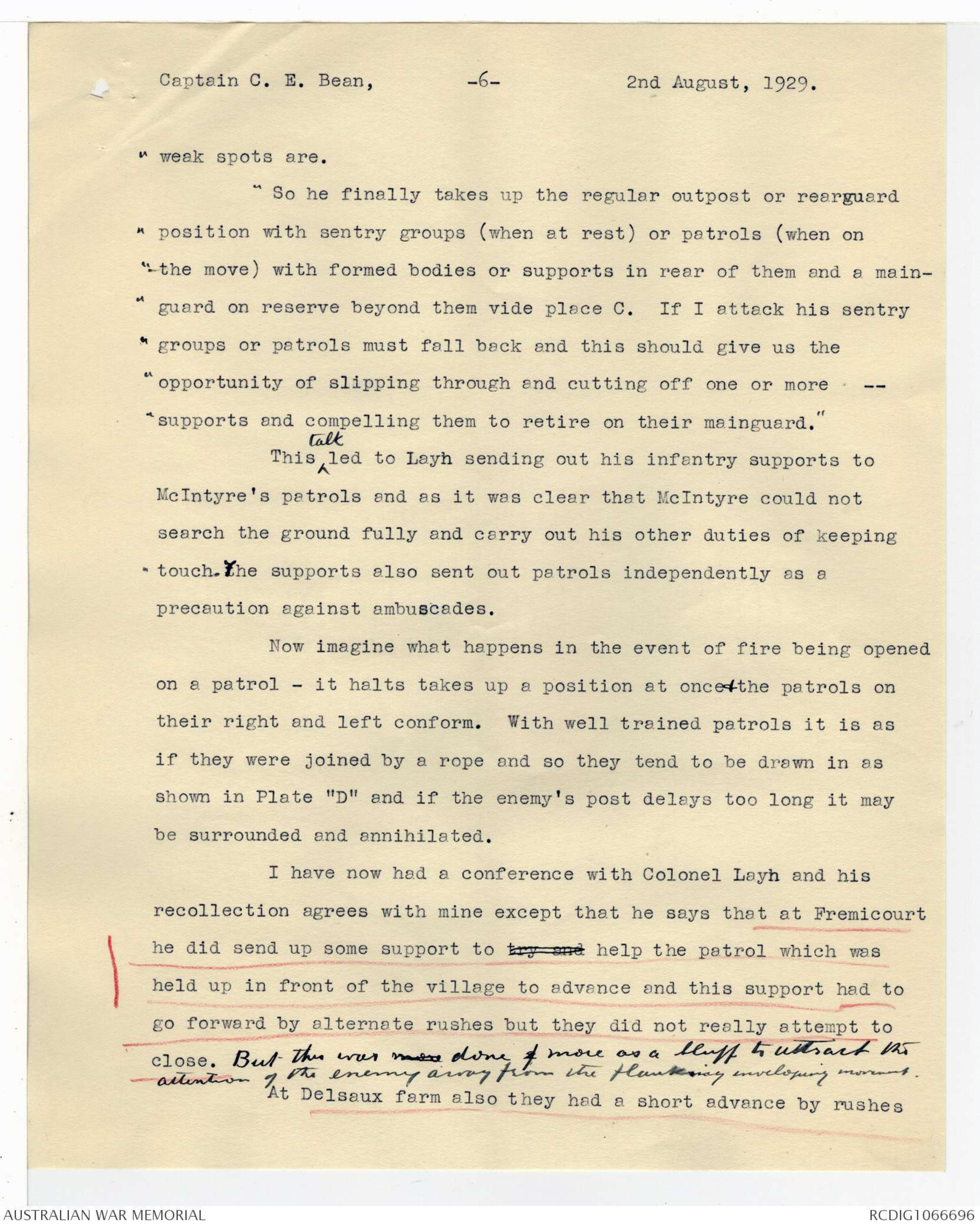
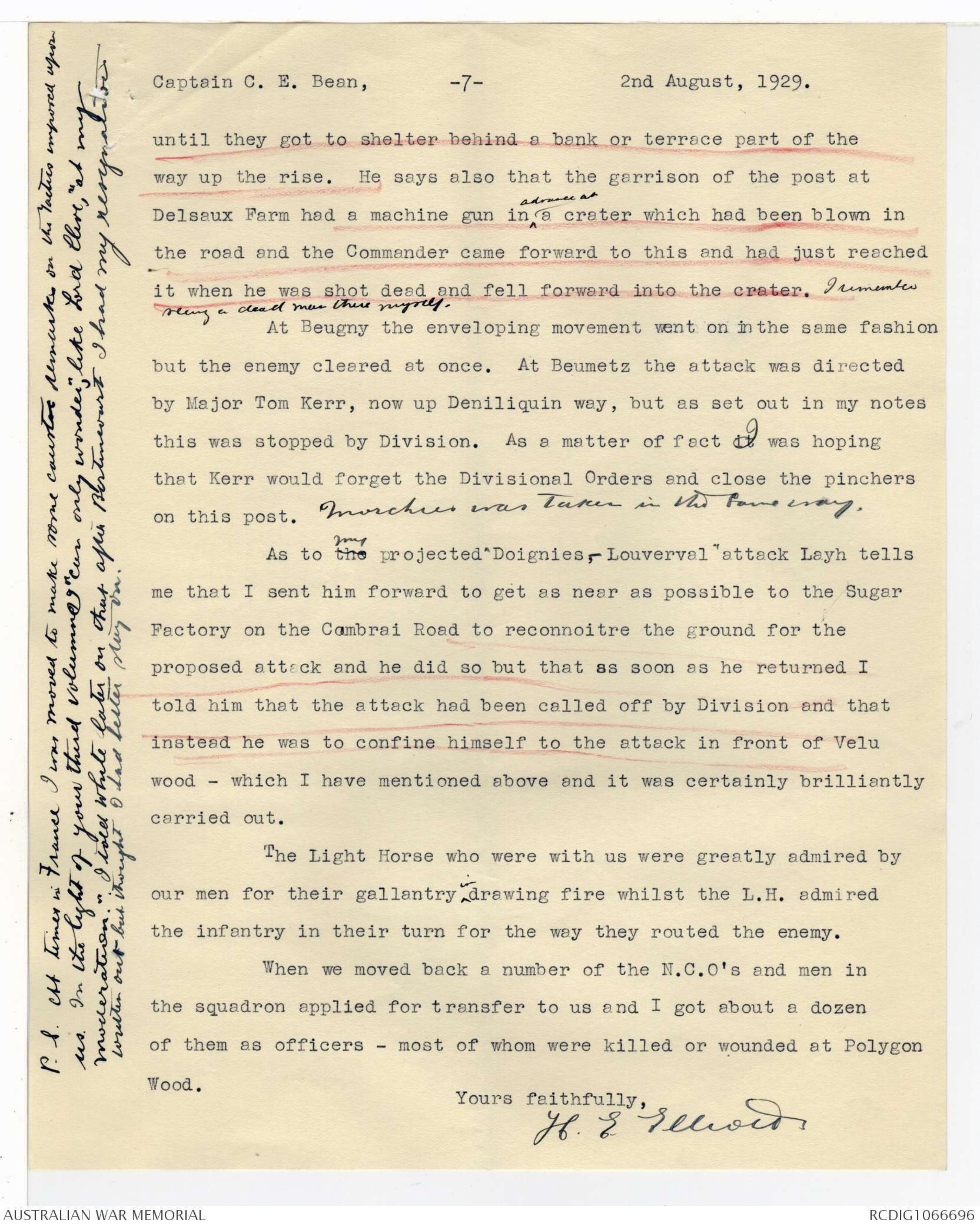
.8.
was the only time during the war except
the Krithia attack where as far as I
know the attack was carried out strictly
as we practiced it at Broadmeadows
& Mena Camp. The enemy could not
mind it & fled helter skelter whilst
Phillips Batteries had the time of their
lives shelling tho not as it rushed
back to Hermies.
You could no doubt get an
account of this from Phillips now
stationed at Adelaide
I forget just what happened on the
23rd March.
My diary reads under date 23. rd March
"Fine day but Very Cold. At 2 am the
"Enemy Counterattacked at Beaumetz after
"A Bombardment but was driven off
"Afterwards I planned an attack on him
"to clear up the remnants of this attack
"who were ^ exposed lying out in the open but
"was fobidden by Divisional H.Q. I think
"we could have easily got Louverval &
"Doignies as these men would have retired
"& marked the enemy's fire & we could have
"entered the position with them."
I desired I think to teach the enemy
a lesson & improve my position next
day after again driving off a counterattack
by fresh troops I made the advance above
described. The fact that the enemy
9
COMMONWEALTH OF AUSTRALIA
THE SENATE.
FEDERAL MEMBERS' ROOMS.
TEMPLE COURT.
422-428 COLLINS STREET.
MELBOURNE.
had to call up fresh troops supports
my opinion that the men in front
of us would have bolted if you
stamped your foot at them
You will note that my Order No 8 is
conveniently ambiguous. I had hoped
that Gen Hobbs would pass it bye by as
he had the one for the Capture of Beaumetz
It does not say - "will capture" etc - but musts "attack the
line". etc
I dont think there was any order
absolutely forbidding any attack - but
simply that we must not bring on a general
attack - I managed to persuade him that
the 58th attack would not be likely to do
that & he let us do it.
"Corps" & "Divisoin" seemed so blessed "windup"
about my position at this time that they
would give me no direction & the wonderful
tactical advantage we had gained by
getting behind the enemys line to right
and left was simply frittered away. Could
you let me have a copy of the message to
Division. I dont appear to have it. It
P.T.O
[*may recall my recollection of the
circumstances. I will write again
after I have seen Layh tomorrow.
Major Tom Kerr 60th Bn saw a good deal of
the fighting also Doyle & Keith MacDonald
Yours faithfully H E Elliott *]
10
P.S. The orders instruction to the advanced guard
Commanders were never to frontally
attack - but that on meeting opposition
snipers & machine gunners were to keep
the enemys heads down whilst the L.H &
infantry patrols worked round the flank
& surrounded them - but the Broche would
never wait until they were surrounded
but got while the going was good
Vide Diagram.
Diagram - see original document
Again these are diagramatic
only & varied with the ground.
N.B. That if I were detailed to do a rear guard
I would not have entrenched posts. They give
cover but clearly risk the positions to be
avoided. Also the men in them cannot
see to any extent particularly if the parapets
are being swept by machine gun fire as
we found at loan Lone Pine - the dust
rained by the run of bullets & the attackers can
if the ground is favorable get close up even in front
of you without you being able to stop them - &
can easily surround you if isolated. On the
surface behind natural cover you can see better
& are not so noticeable yourself. Of course in a
fight. to a finish you must intrench - but
a rearguard that fights to a finish is done for
& fall down on its job
[*Not ordy advd & Reargds - Gs were not
returning but giving themselves time.
By the 18th the retreat was over. The
G. rearguards were merely giving time
to complete new line.
Gelly was well ahead on 18th
(not as Elliott says) behind.
Sigs & wire - laid to every
outp. Coy
Noreuil - G main line of posts*]
[*59th took Bertinet
on night of 19th (10pm)
LH sent to
relieve them.*]
H.E. ELLIOTT & CO.
SOLICITORS
H.E. ELLIOTT, B.A.,L.L.M.
NOTARY PUBLIC, COMMR. FOR ALL
STATES AND TERRITORIES
TELEPHONE CENT. 1871
CABLES AND TELEGRAMS
"LARISTAN." MELBOURNE
Royal Automobile Club Building
94-98 Queen Street
Melbourne, C.1. 2nd August, 1929.
HE/MG
Captain C. E. Bean,
Commonwealth Historian,
Victoria Barracks,
SYDNEY. N.S.W.
Dear Captain Bean,
With further reference to yours of the 30th July
I took the opportunity last night of reading over the chapter in
Captain Ellis' Book dealing with the Advance beyond Baupaume to
refresh my memory on these events.
Taking it on the whole it is quite a good account but -
dealing with the question of the attack on Louverval and Doignies
he commits some amusing blunders. At page 189 he writes -
"It was originally decided to encircle Louverval from the -
"north and Doignies from the South but this plan would have exposed
"the Southern Column to the menace of a flank attack from Hermies.
"So acting on General Hobbs' advice General Hobkirk substituted
"for this a more original and less risky form of attack."
He set out this plan in detail with a sketch. Now as you
will realize from a study of the documents the "original decision"
was mine but General Hobbs turned it down, as I then understood it,
because he was afraid it would bring on a general engagement which
Corps had frowned upon. Now Ellis says it was "because it was too
risky" yet on page 189 he says - "the operations were commencing to
"assume the character of a series of pitched battles. This was
-2-
Captain C. E. Bean,
2nd August, 1929.
"the object most sought by General Hobbs and most avoided by the
"enemy."
That statement is absolutely contrary to the facts. It
represents what ought to have been "Corps Policy" and "Divisional
Policy" but in point of absolute fact they had effectually between
them prevented it even from being "Brigade Policy". I fully expected
to be counter attacked from Hermies and was doing all I could to
provoke it - in fact it was the one especial thing I desired - to
tempt them the Bosche out of their prepared positions by appearing to be taking
dangerous risks-but keeping careful watch at every point.
The defence is now so strong with, Vicars guns, Lewis guns
and magazine rifles that we need have feared nothing under less than a set
attack behind a Barrage and if they attacked as they did at --
Beaumetz they were really at our mercy.
Now returning to the attack as carried out by Hobkirk on
Hobbs' advice.
Ellis calls it "a more original". He may well call it
such. It is of such a sort that no one with any sense of tactics
would have claimed the parternity of the plan at all.
Observe on page 191 - he says Hobkirk rejected any
bombardment and preferred to rely on "complete surprise".
Consider the position. Suppose you were a burglar and
wanted to get into the house as a "complete surprise". Naturally
you would refrain from throwing bricks on the roof or setting off
bung-bung crackers around the house. So far Ellis and I are, I
assume, in complete agreement but having lead off with that statement
-3-
Captain C. E. Bean,
2nd August, 1929.
would you expect what follows :
The burglar walks up the garden path to the main front
entrance and not only delivers a thundering knock on the door but
seeing the watch dog sleeping peacefully on the door mat he rouses
the brute to ferocity by placing a violent kick in his ribs.
I venture to say that if you one were on a jury to try the
fellow for attempted housebreaking you one would be strongly inclined to acquit him notwithstanding the revolver in his pocket and his
previous police record and would probably approve of the Magistrate
remanding him to a receiving home for mental cases.
Now we will consider Hobkirks' or was it Hobbs' plan.
He knew about the "watch dog" i.e. the Sugar Factory. We
had observed it closely and it looked uncommonly like a "man trap"
machine gun nest commanding the road. This road was the front door
to the enemy's mansion and was certain to be closely watched.
Therefore as the route for a surprise attack it was the
least ^one to be thought of - or so I would have imagined. It is true^that at
Peronne I took a somewhat similar route but not in the hope of a
surprise but as a desperate gamble in the attempt to prevent a
helpless slaughter of the 14th. True it came off but it is not to
be recommended as a general practice.
Then the rest of the attack, though wonderfully well done
by the 14th Brigade, was another blunder -a direct attack mainly
frontal on a strongly fortified position, defended by mines, barbed
wire, and so on. I think the plan must have beed been adopted from the
Bosche counter attack or Beaumetz - but he got what he deserved.
My brother as M.O. of one of the Battalions took part and
-4-
Captain C. E. Bean,
2nd August, 1929.
admired greatly the splendid behaviour of the men ^in the attack who rushed recklessly
and gallantly through the wire and the exploding mines upon the --
enemy who apart from the great strength of their position put up only
a feeble resistance. but Nevertheless the whole operation had in it
all the elements of a terrible disaster. As it was ^though made upon troops
that I had harried and worn out, the 14th Brigade sustained in that
one night out of the two battalions engaged, far more casualties than
all the Battalions under me from start to finish.
I told my brother at the time that both places could have
been taken with one tenth of the casualties and he was rather --
indignant thereat as he did not understand tactics either.
Reflecting upon it after all I am coming to the conclusion
that our F.S.R. were about as intelligible to the average officer
- British as well as Australian-as I found the Egyptian Heiroglyphics
I saw at the Cairo Museum but which the Curator kindly read to me
with ease and fluency.
When this advance was over the War Office people demanded
from me a report on how the job was done much as you are doing now.
In my reply, given under the influence of the strafe I got from
Birdwood and White the latter of whom told me I should have "to
modify my napoleonic ideas", I replied said "By following the F. Service
Regulations". That was not considered sufficient and they sought
further information. I declined to give them any but allowedWieck to
send in a report.
He was not however present at the conference I held with
Layh and his officers and the Light Horse Commander Captain McIntyre
-5-
Captain C. E. Bean,
2nd August, 1929.
near Ligny Thilloy as he had to bring the transport round by
Warlescourt.
If you omit the portion about Scipio you will find the
gist of what I said to them ^set out in my notes of the lecture which I
delivered recently to militia officers here and which I enclose
for your perusal and return. I illustrated my meaning at the
lecture with diagrams on a black board similar to those I also
now enclose.
I cannot speak too highly of Layh's work, nor of that of
Captain McIntyre and his men. Layh's and McIntyre were both old
militia officers and all this open warfare stuff was "what we
grow'd on" in all our pre-war and pre-Gallipoli training and a few
words made my plans and ideas clear to them.
Analysing my thoughts for your benefit (and as I ought
possibly ^to have done at the time and would certainly have done if not
so grossly affronted by Birdwood over the Bertincourt matter) ^in my
endeavour to put myself in the enemy's place and thus see over the
hill into what he was doing and thinking, my subconscious mind
would run along something like this- "The enemy's line before us
"before he retreated was as in plate "A" attached. The moment he
"starts to retreat by alternate bodies, as he must do, his line
"takes the form momentarily as shown in plate "B".
"He endeavours to cover the gap so left by spreading out
"the force which remains behind.
"He will not do this uniformily butwill retain a formed
"support in his hands and trust that we will not discover where the
-6-
Captain C. E. Bean,
2nd August, 1929.
"weak spots are.
"So he finally takes up the regular outpost or rearguard
"position with sentry groups (when at rest) or patrols (when on
"-the move) with formed bodies or supports in rear of them and a
"main-guard on reserve beyond them vide place C. If I attack his sentry
"groups or patrols must fall back and this should give us the
"opportunity of slipping through and cutting off one or more --
"supports and compelling them to retire on their mainguard."
This ^talk led to Layh sending out his infantry supports to
McIntyre's patrols and as it was clear that McIntyre could not
search the ground fully and carry out his other duties of keeping
touch. The supports also sent out patrols independently as a
precaution against ambuscades.
Now imagine what happens in the event of fire being opened
on a patrol - it halts takes up a position at once & the patrols on
their right and left conform. With well trained patrols it is as
if they were joined by a rope and so they tend to be drawn in as
shown in Plate "D" and if the enemy's post delays too long it may
be surrounded and annihilated.
I have now had a conference with Colonel Layh and his
recollection agrees with mine except that he says that at Fremicourt
he did send up some support to try and help the patrol which was
held up in front of the village to advance and this support had to
go forward by alternate rushes but they did not really attempt to
close. But this was more done / more as a bluff to attract the
attention of the enemy away from the flank [[?]] enveloping movement.
At Delsaux farm also they had a short advance by rushes
-7-
Captain C. E. Bean,
2nd August, 1929.
until they got to shelter behind a bank or terrace part of the
way up the rise. He says also that the garrison of the post at
Delsaux farm had a machine gun in ^advance at a crater which had been blown in
the road and the Commander came forward to this and had just reached
it when he was shot dead and fell forward into the crater. I remember
seeing a dead man there myself.
At Beugny the enveloping movement went on in the same fashion
but the enemy cleared at once. At Beumetz the attack was directed
by Major Tom Kerr, now up Deniliquin way, but as set out in my notes
this was stopped by Division. As a matter of fact I was hoping
that Kerr would forget the Divisional Orders and close the pinchers
on this post. Morchies was taken in the same way.
As to the my projected "Doignies,-Louverval" attack Layh tells
me that I sent him forward to get as near as possible to the Sugar
Factory on the Cambrai Road to reconnoitre the ground for the
proposed attack and he did so but that as soon as he returned I
told him that the attack had been called off by Division and that
instead he was to confine himself to the attack in front of Velu
wood - which I have mentioned above and it was certainly brilliantly
carried out.
The Light Horse who were with us were greatly admired by
our men for their gallantry ^in drawing fire whilst the L.H. admired
the infantry in their turn for the way they routed the enemy.
When we moved back a number of the N.C.O's and men in
the squadron applied for transfer to us and I got about a dozen
of them as officers - most of whom were killed or wounded at Polygon
Wood.
Yours faithfully,
H. E. Elliott
[*P.S. At times in France I was moved to make some caustic remarks on the tactics imposed upon
us. In the light of your third Volumne "Can only wonder", like Lord Clive, "at my
moderation." I told White later on that after Bertincourt I had my resignation
written out but I thought I had better stay on.*]
 Sandy Mudie
Sandy MudieThis transcription item is now locked to you for editing. To release the lock either Save your changes or Cancel.
This lock will be automatically released after 60 minutes of inactivity.